This isn’t a car. And I don’t mean that in the Marks & Spencer “this isn’t just a car” way – more like the opposite.
The Citroën Ami isn’t a car because, although it has four wheels, a motor, two seats, two doors, two pedals and a steering wheel, it’s a quadricycle – a category of small, light vehicle that also includes the Renault Twizy and, if you recall, the Reva G-Wiz.
In some European countries, a quadricycle brings with it certain liberties. You may drive it without needing a full driving licence or from as young as 14 (although not in the UK). They also don’t get crash-tested as rigorously as cars, nor do they have to comply with the latest emissions regulations, as you’ll know if you’ve followed some chugging two-stroke snotter along a French lane, where they seem most popular.
You used to see quite a few G-Wizes in London, too. An anaesthetist who was about to sedate me for some significant dental treatment owned one and asked me what I thought of them. Because he would be in charge of how awake I was while my dentist hammered and screwed things into my jaw, I told him: “I think they’re great.”
Obviously, I was lying through my… er… gums. But since seeing the Ami One concept at the 2019 Geneva motor show, I’ve been quite into the idea of this small Citroën alternative. It has now been productionised and, without the One suffix, the Ami is available for sale or rent in France, with other left-hand-drive countries due to follow in early 2021. Citroën would like to make it available in the UK, too, but its chances depend on public reaction, so if you want one, you will have to tell them.
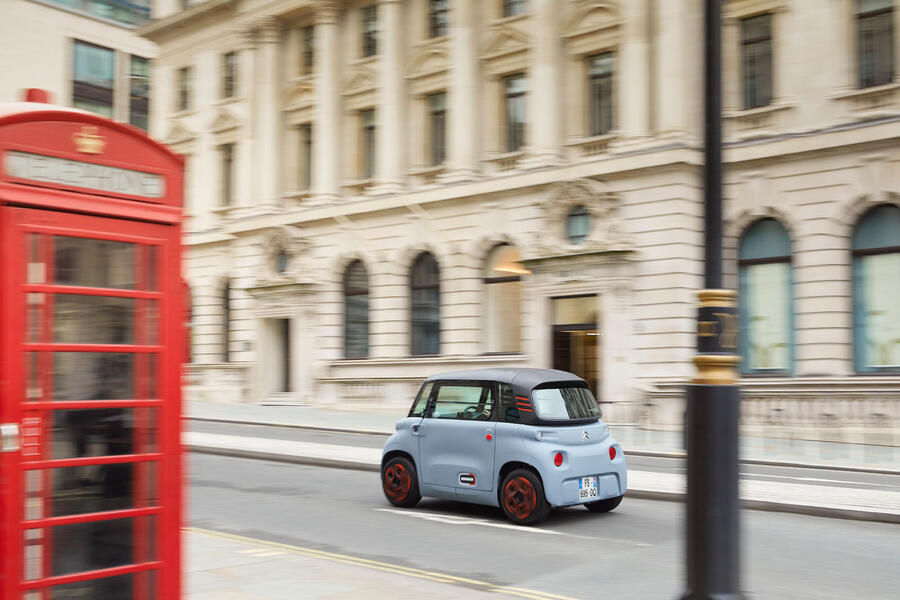
It’s small – just 2.41m long and 1.39m wide – and light, at 425kg without batteries. Its pre-battery weight of more than 350kg makes it a heavy, not a light, quadricycle, which is why UK drivers can’t pilot it at 16 after just a motorcycle training day (CBT) as they could a light quad.
Anyway, with 5.5kWh of battery under its floor, the Ami weighs 485kg and has a range of 43 miles and a regulated top speed of 28mph. The Ami has changed a bit since the Ami One concept, which was altogether glossier and more slickly finished than the small grey plastic box you see before you, but there are similarities.
The Ami One had some very simple themes to reduce cost, and they’ve been continued onto the production car. The doors are identical left and right, so the driver’s door is rear-hinged while the passenger’s isn’t. Each small corner panel is the same as the three others and so are the front and rear panels. The direction of travel, then, you will tell by different light colours and the slope of the roof and glass area.
A large push button opens the doors from the outside; a pull on fabric releases them from inside. There’s a standard sunroof and the glass area is said to occupy almost half of the interior surfacing, so this is a bright, airy not-a-car. From the driver’s seat, mounted nearer the back than the front, the windscreen is miles away. Everything that isn’t glass, or the exposed steel spaceframe to which the body is mounted or bonded in Citroën’s Moroccan factory, is finished in hard plastic.
Try not to think it too much like piloting a portable loo. Half of the side windows flip to hinge upwards, a bit like an old Citroën 2CV’s. That’s your cooling. There’s a one-speed fan, which also has a heat option. Push its button and the noise is like a service station hand-dryer. Stand about three metres from one of those and that’s how effective it feels, too, although it does ultimately warm the cabin and keep glass mostly fog-free.
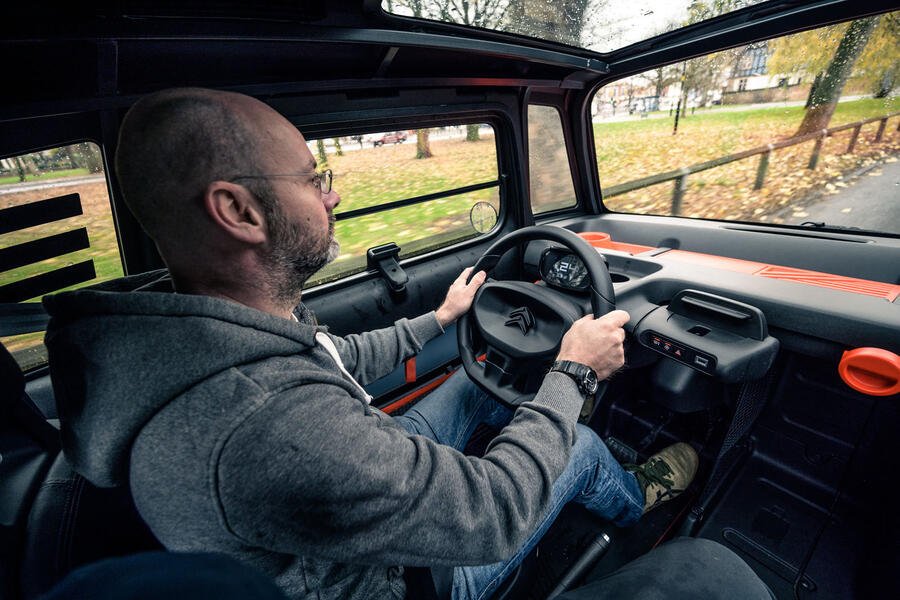
There are flashes of colour inside – in the form of removable holders and cubbies on the dashboard. If you don’t like their colour, swapping them for others would take seconds. The rear glass doesn’t open. Any luggage is relegated to the footwell of the very spacious passenger side, whose seat is mounted even further rearward and has no adjustment, and a net is meant to stop bags sliding into the pedal box.
The firm driver’s seat adjusts fore and aft only and the steering not at all. There’s one column stalk, for the indicators and the single wiper, and the headlights are on all the time. The charge cable stows in a cubby behind the passenger door. It has a domestic plug socket and charges in around three hours. There’s no faster charging option because, the thinking goes, this is strictly an urban ‘mobility solution’, as I think the current parlance has it. In other words, it’s as much an alternative to a trip on the Tube or bus, cycling, or a scooter, as it is to a regular car.
And as with electric scooters or bicycles, you can buy one outright or hire one. The Ami costs around £6200 to buy, there are lease deals, or you can hire one in Paris via an app from around 25p per minute. If you do, you’ll have a vehicle that’s quite basic but not without its charms. Anything with four wheels and a kerb weight under 500kg is bound to offer some fun.
It rides stiffly – not as firmly as I remember the Twizy – and steers slowly but accurately. You can easily see where its corners are, so although the door mirrors are small, retaining spatial awareness of things around you is simple. And because it’s 1.52m tall and there’s bodywork around you, being around heavier traffic isn’t intimidating.
It’s not fast, obviously. The motor develops 8bhp (no, that’s not a typo) but electric motors deliver good torque from no revs, and there’s a reduction gear. So front-motored and front-wheel drive, it has enough accelerative urge to chirrup its 165/55 R14 tyres away from junctions; if it’s damp and you have some lock applied, at least. It’s quite nippy.
The turning diameter is a terrifically handy 7.2m. And while cars with left-hand drive often aren’t appealing here because they limit overtaking visibility, that won’t matter with the Ami. Being a left-hooker might even be an advantage, because you can step directly onto the pavement, although locating the charge cable on the road side is suboptimal if you’re parallel parked. Swings, then, meet roundabouts.
You’ll stay warm and dry, unlike on two wheels, but you won’t be able to filter through traffic like a bike. It’s safer than riding, but you still need a driving licence and, although I don’t always like to make the comparison with non-new products, £6000 buys a hell of a lot of used car.
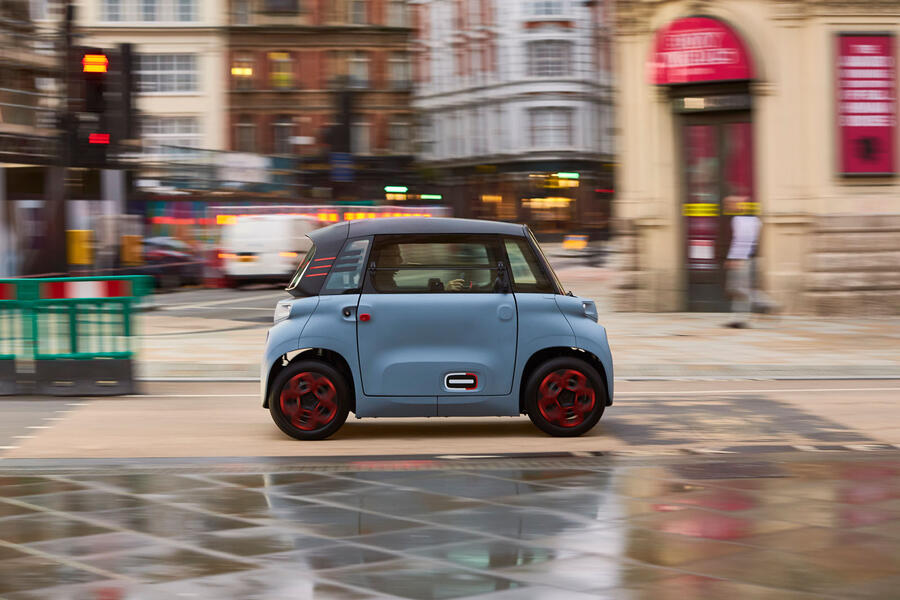
Is it the swings that are good or the roundabouts? I don’t know. But anyway, I think, purely objectively speaking, there are as many downs as ups. Citroën imagines you might see Amis used as second or third cars or featuring logos for small businesses as the quad’s funk overcomes its practical shortcomings. I can imagine seeing that. This is quite an endearing non-car. I couldn’t envisage often recommending one, but if an anaesthetist asked, at least I wouldn’t have to fib about it.
Citroen Ami specifications
Price £6200 (approximate) Engine Front-mounted electric motor Power 8bhp Transmission Fixed ratio, direct drive Kerb weight 485kg 0-62mph You’re pulling our leg, aren’t you? Top speed 28mph (governed) Battery 5.5kWh, lithium ion Range 43 miles CO2, tax band 0g/km, 0% Rivals Renault Twizy, walking
READ MORE
First drive: Citroen Ami One concept

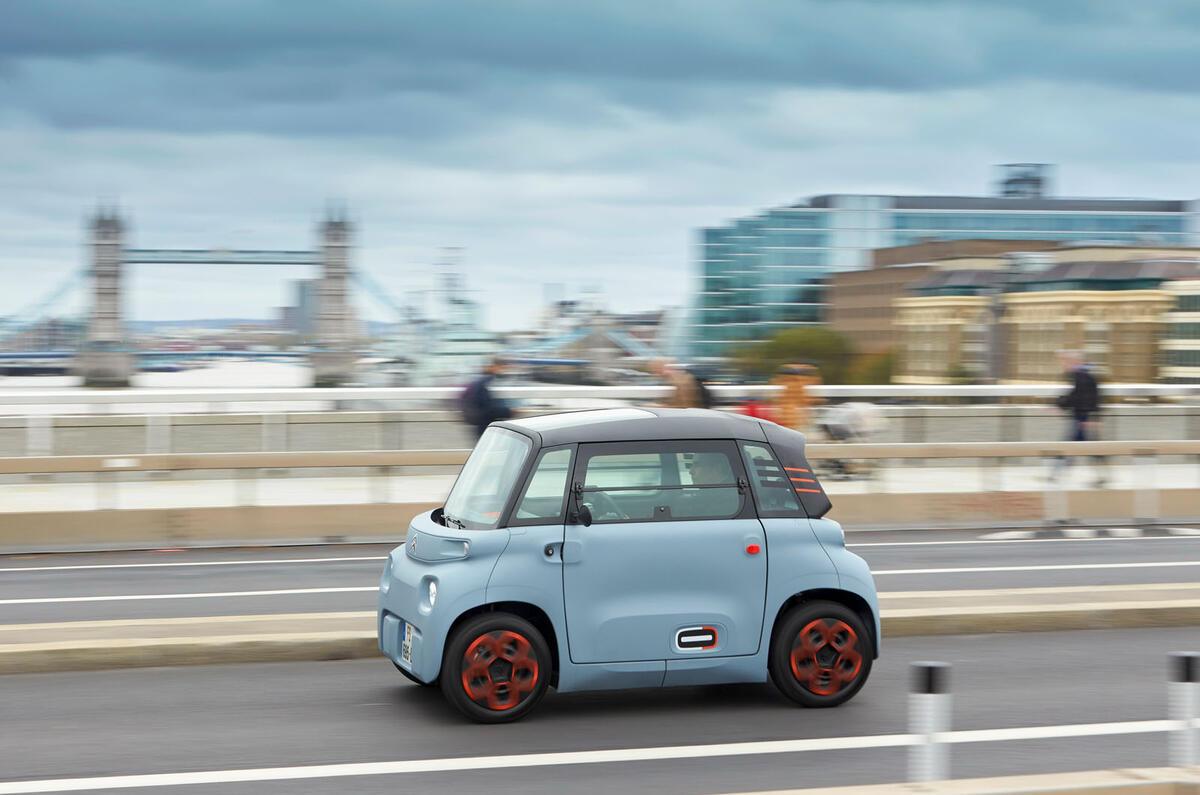
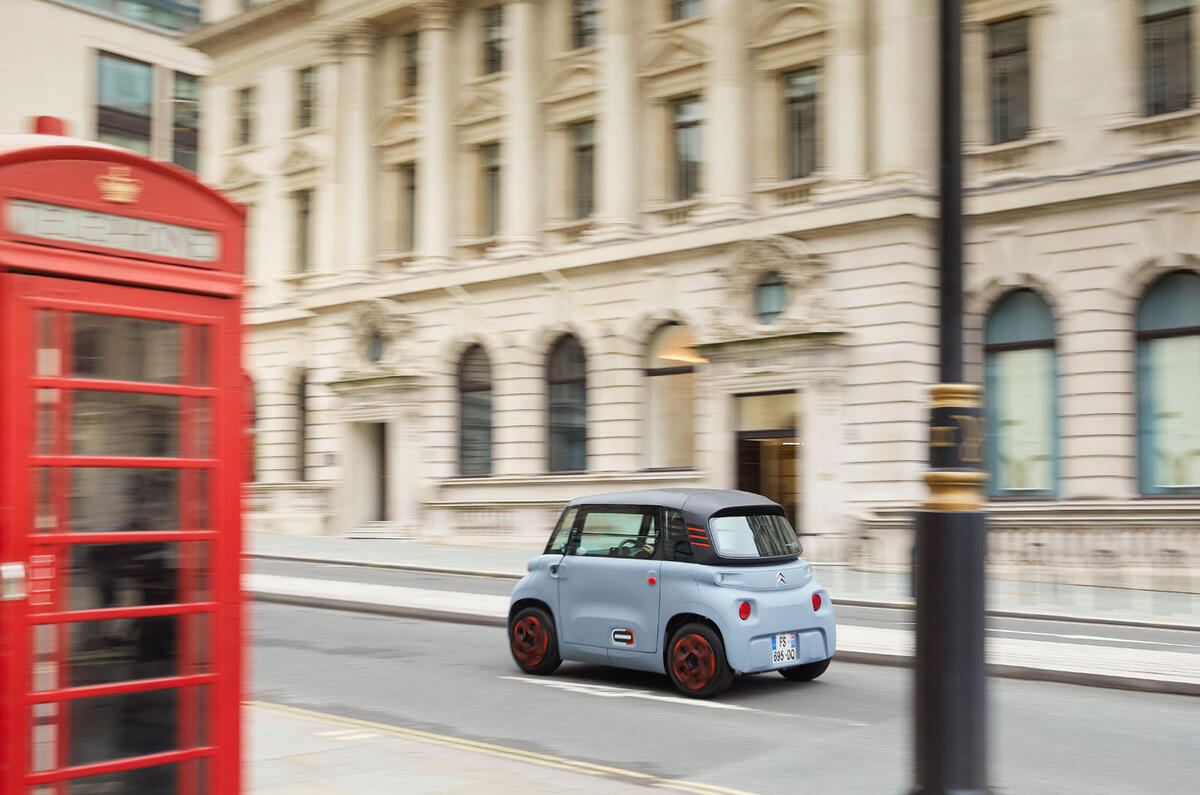
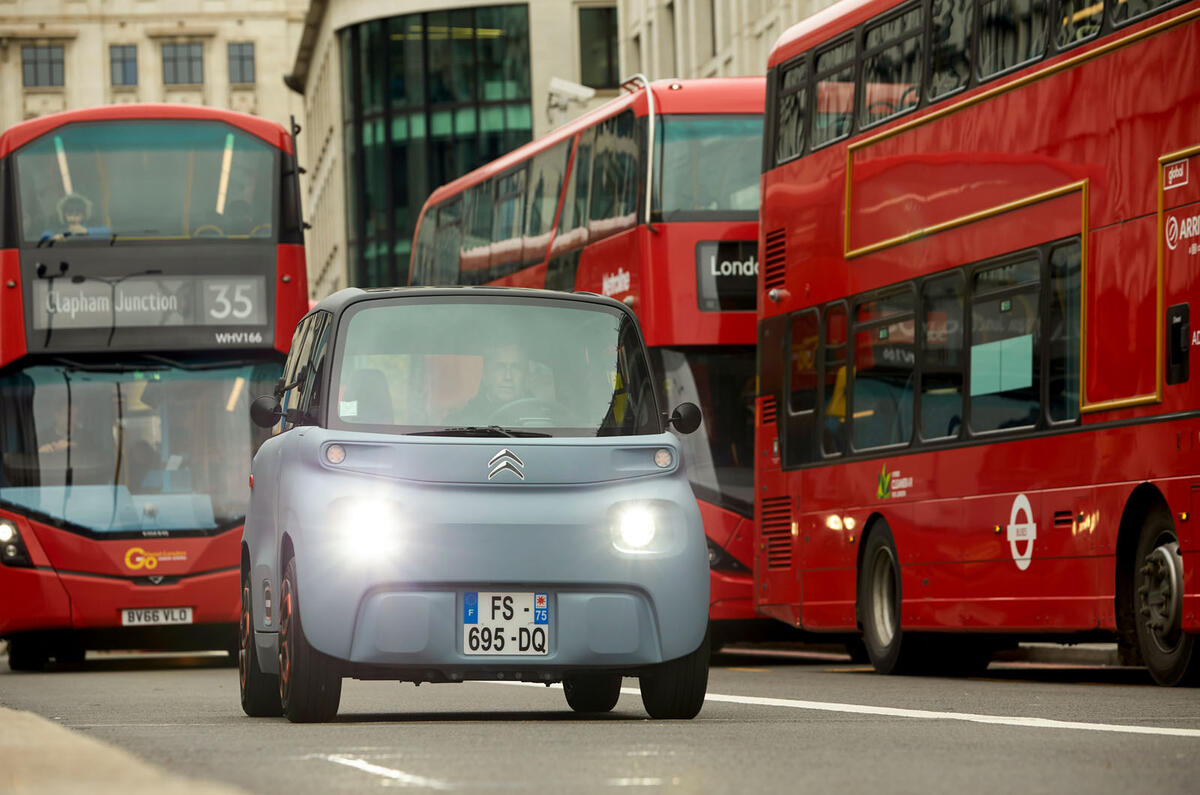
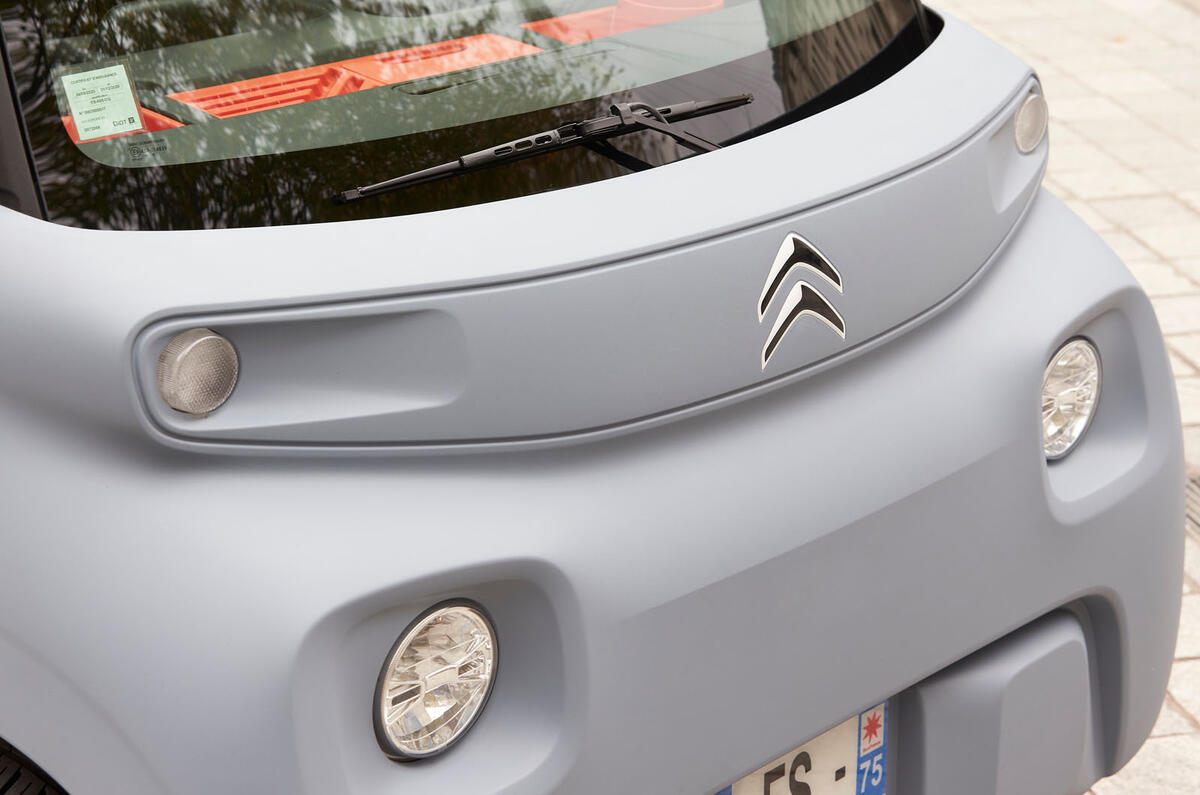
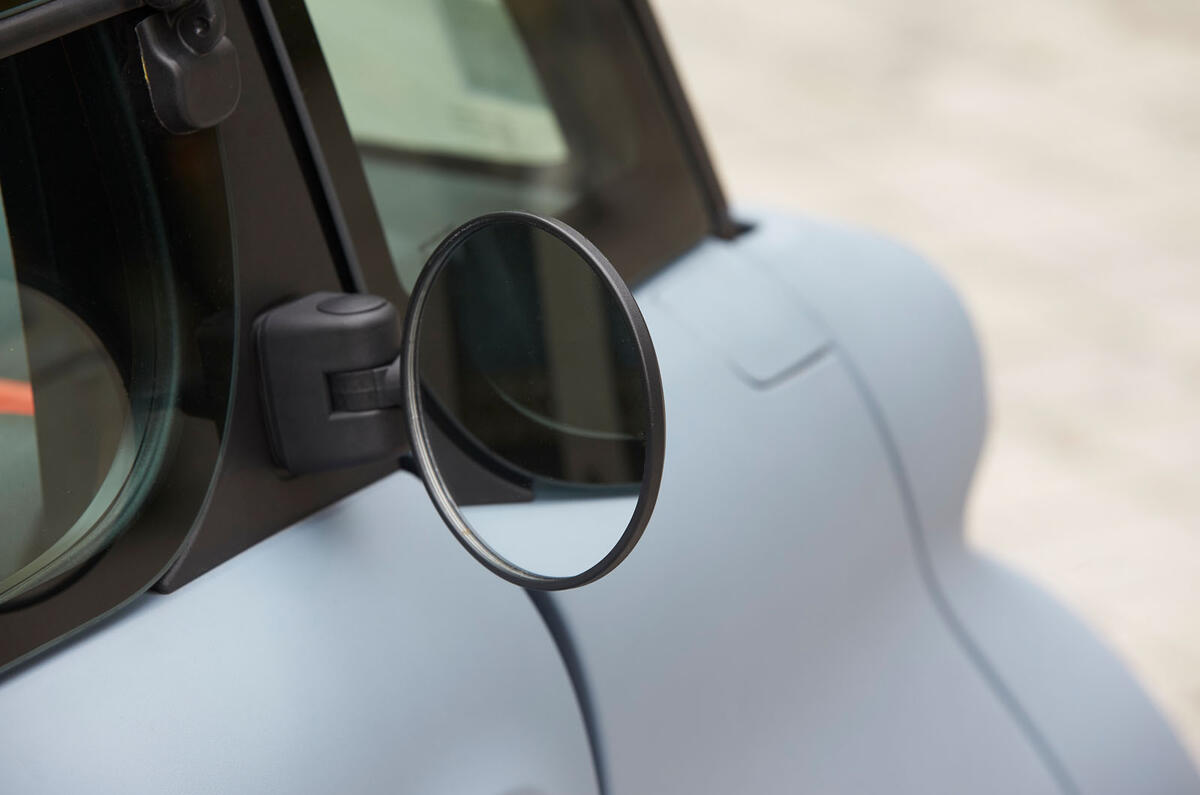
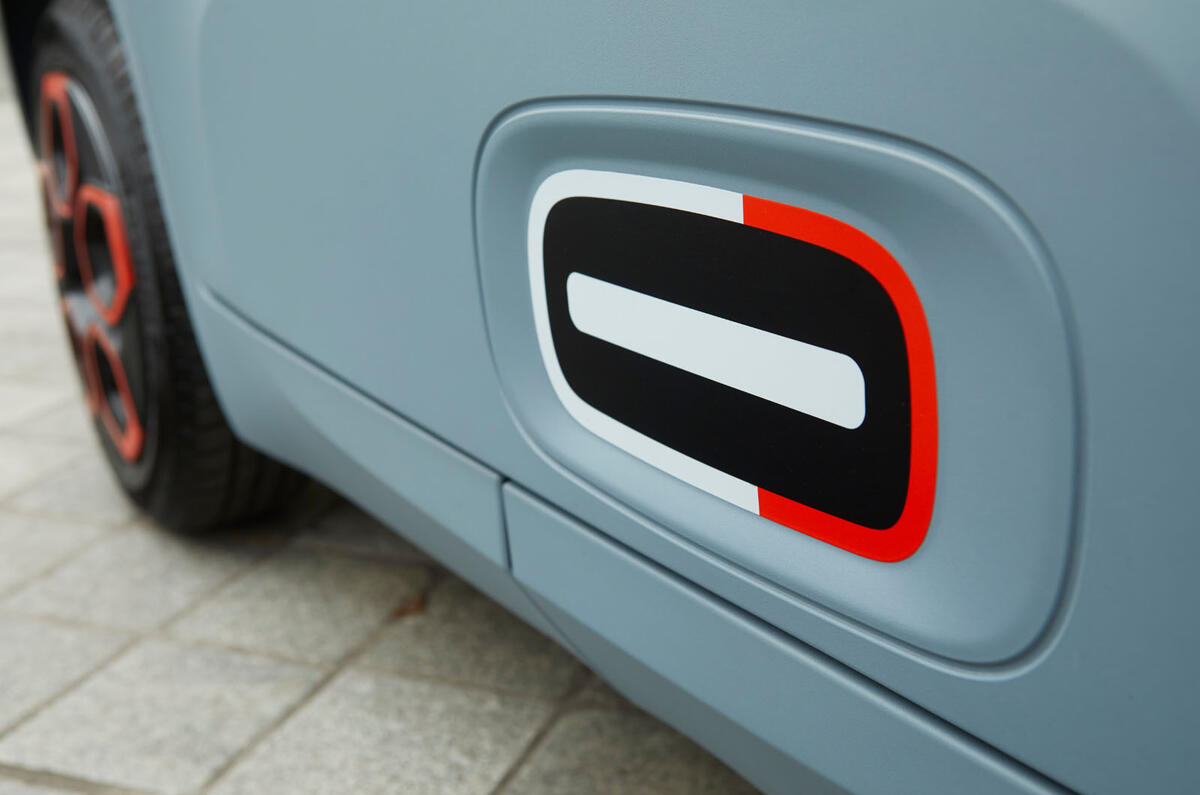
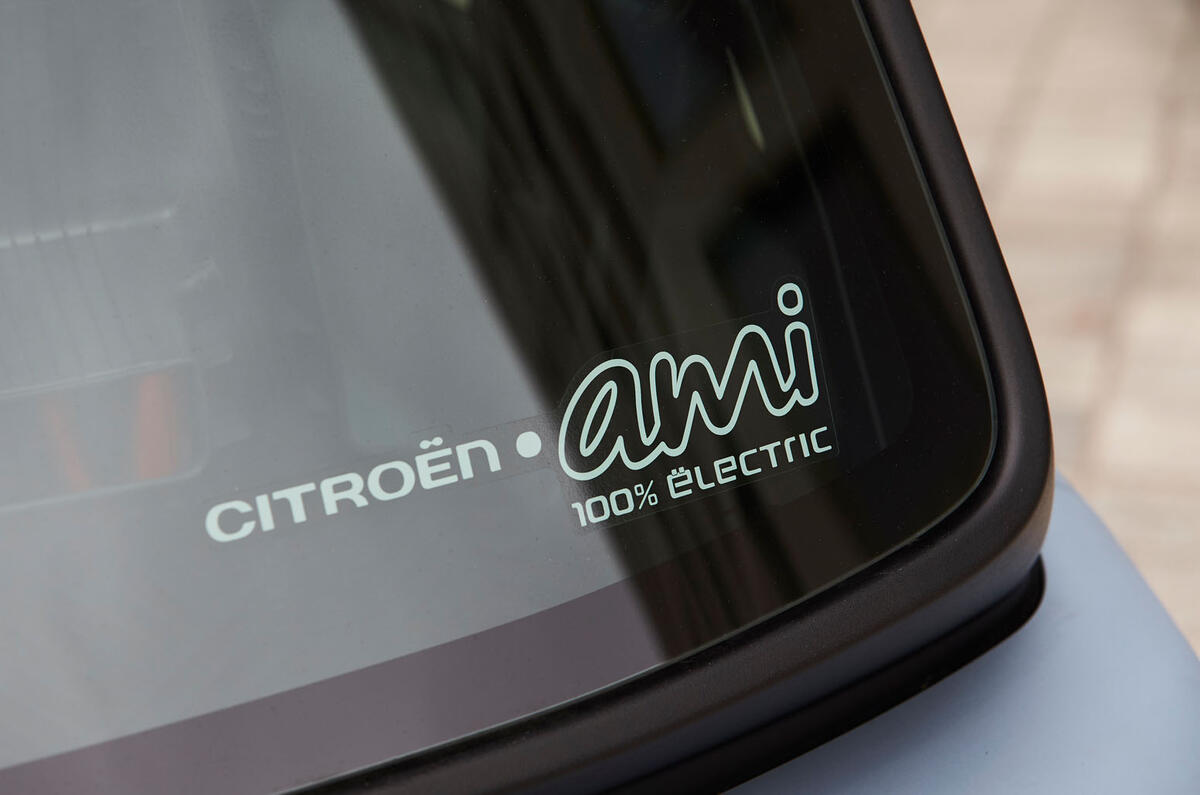
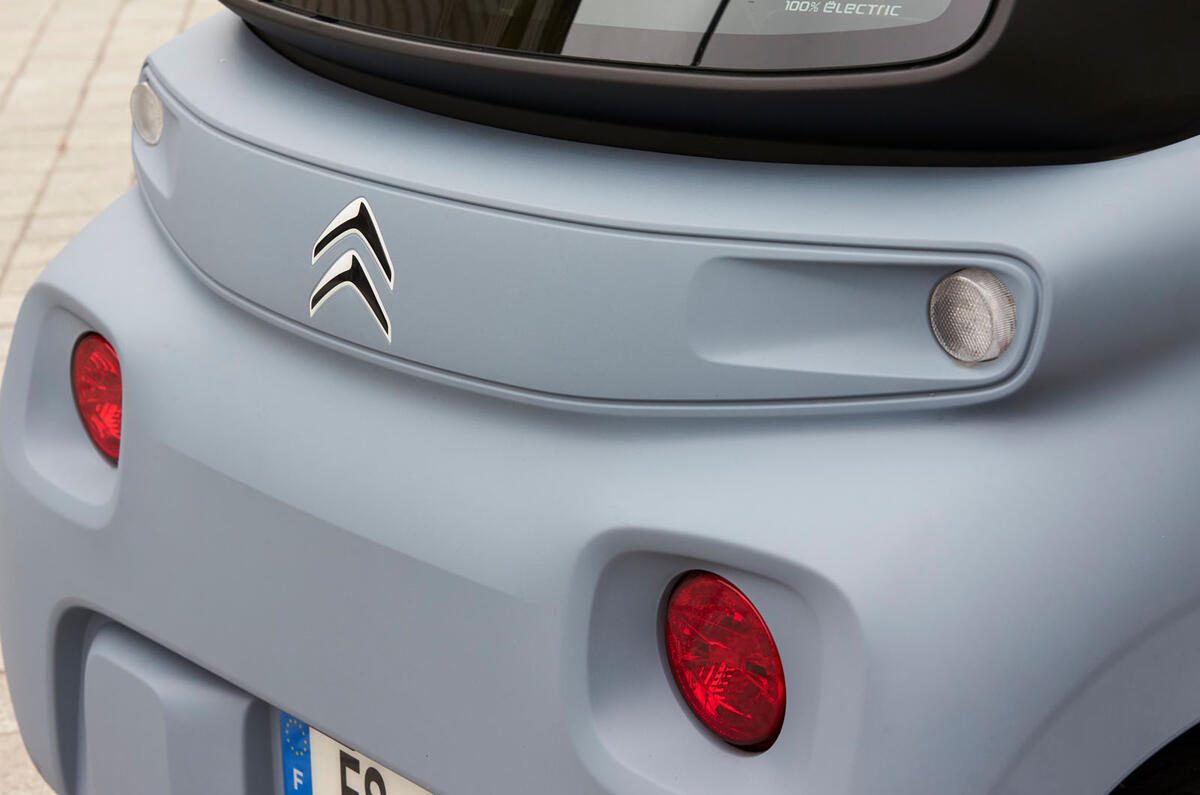
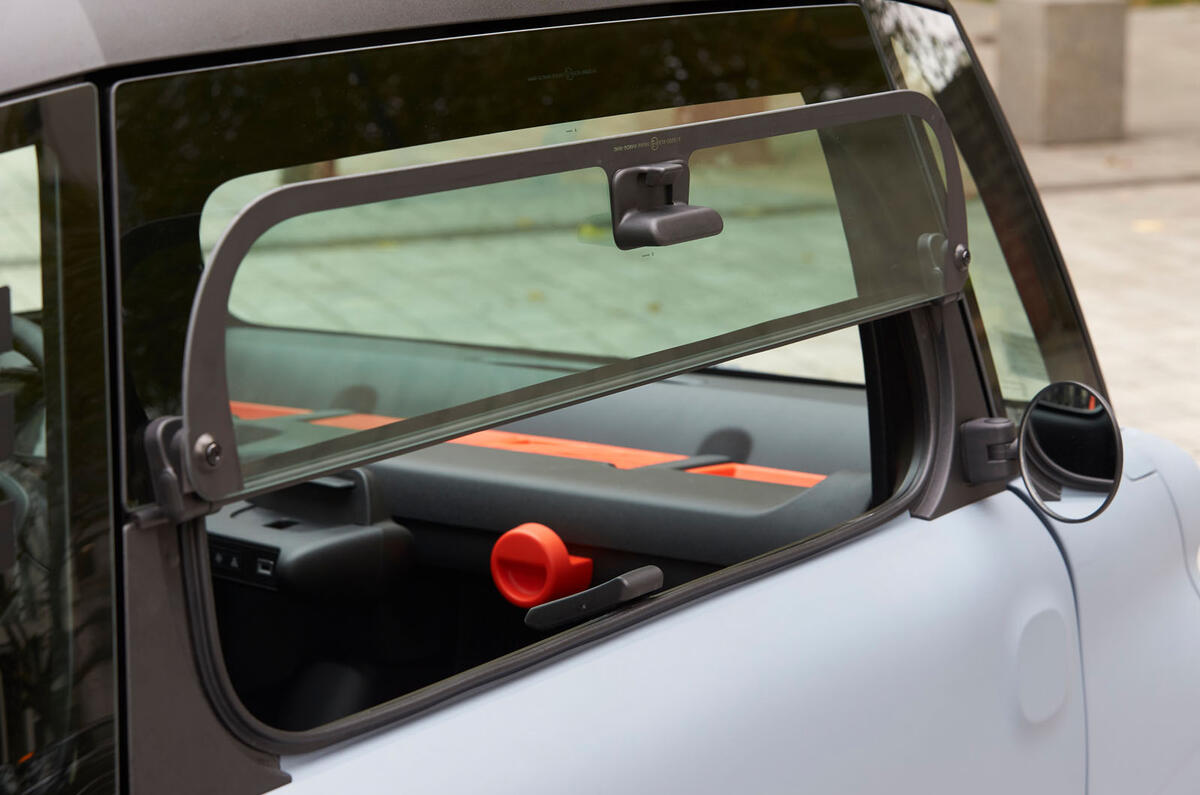
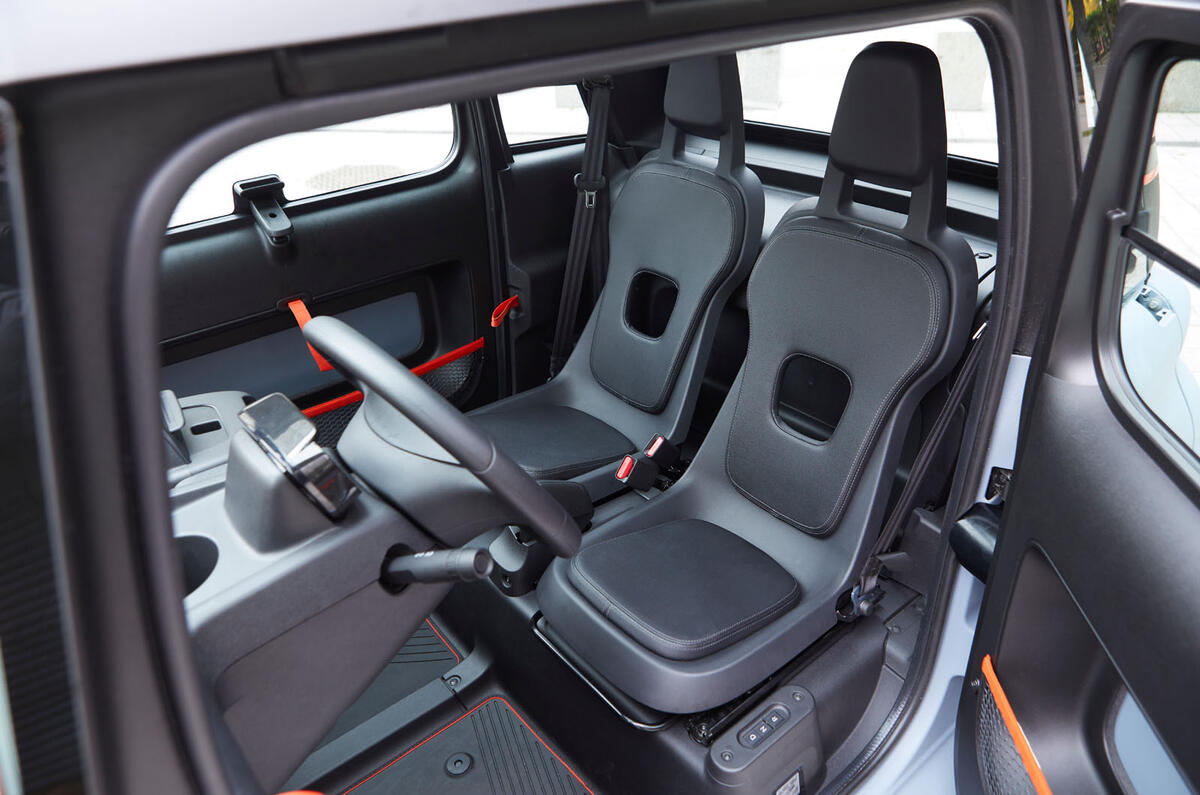
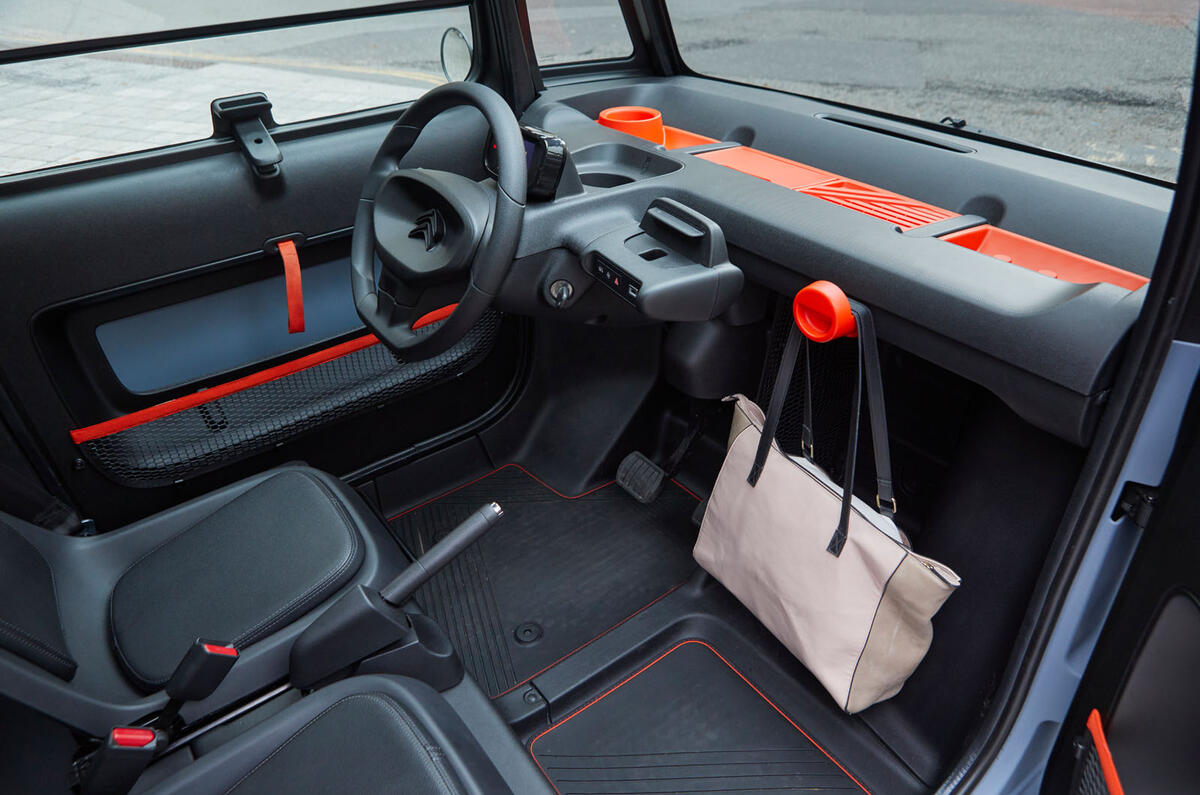
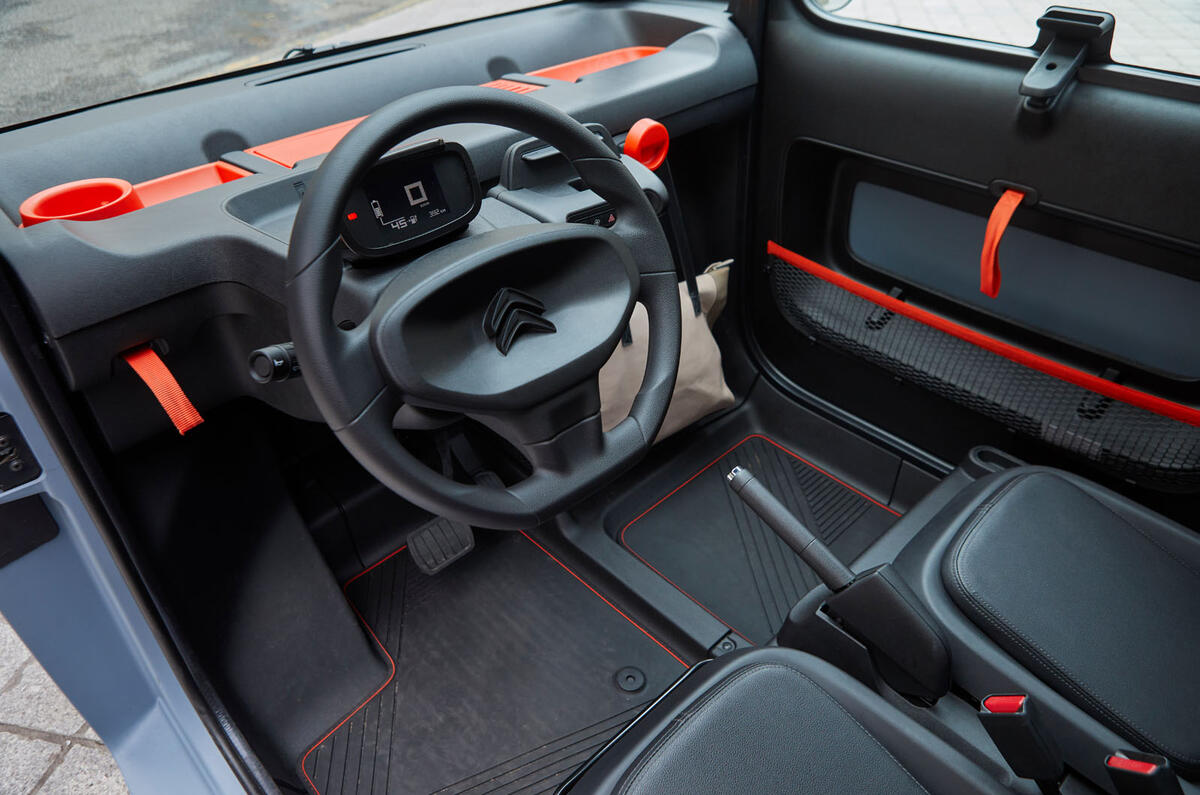
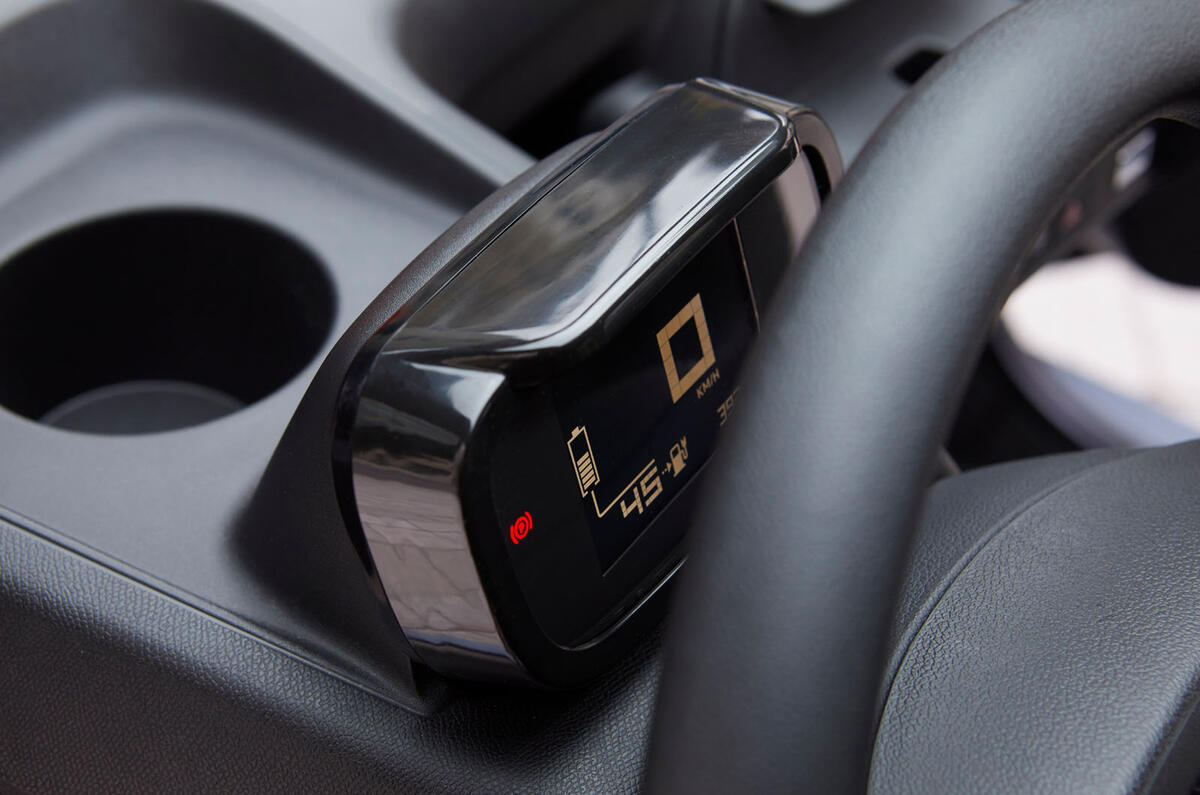
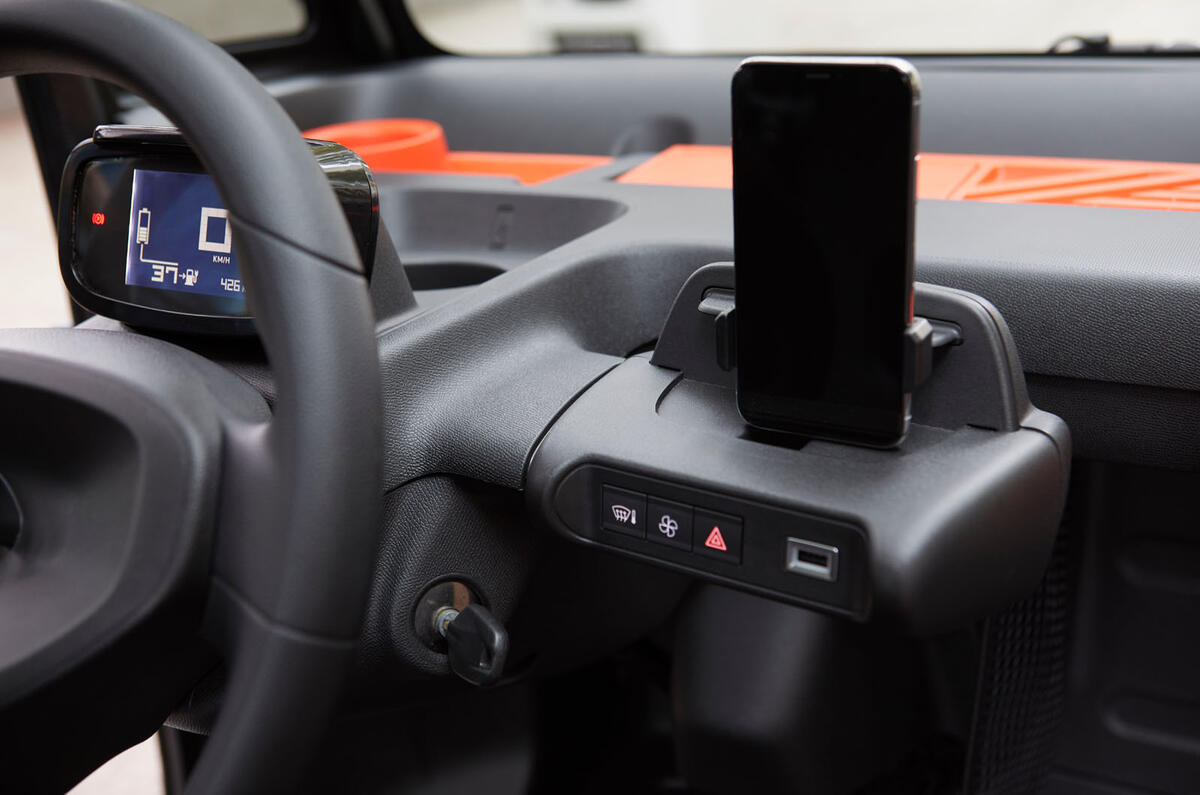
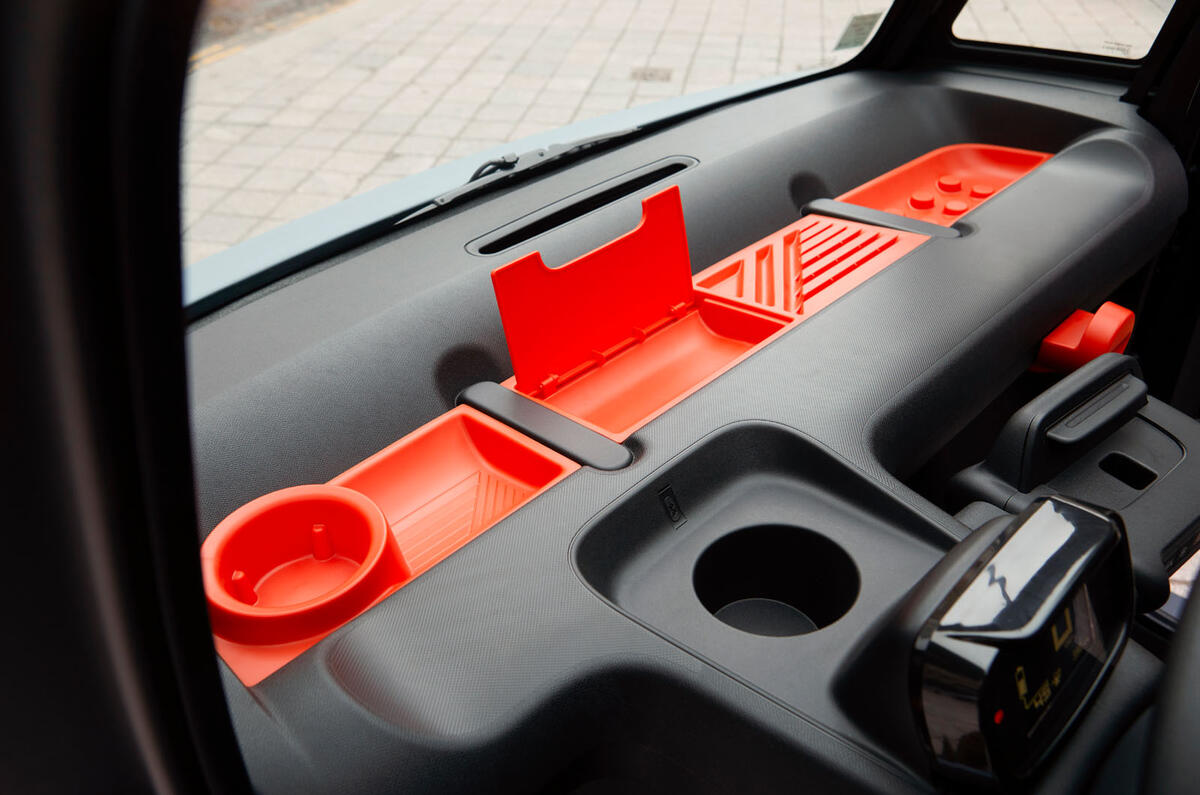
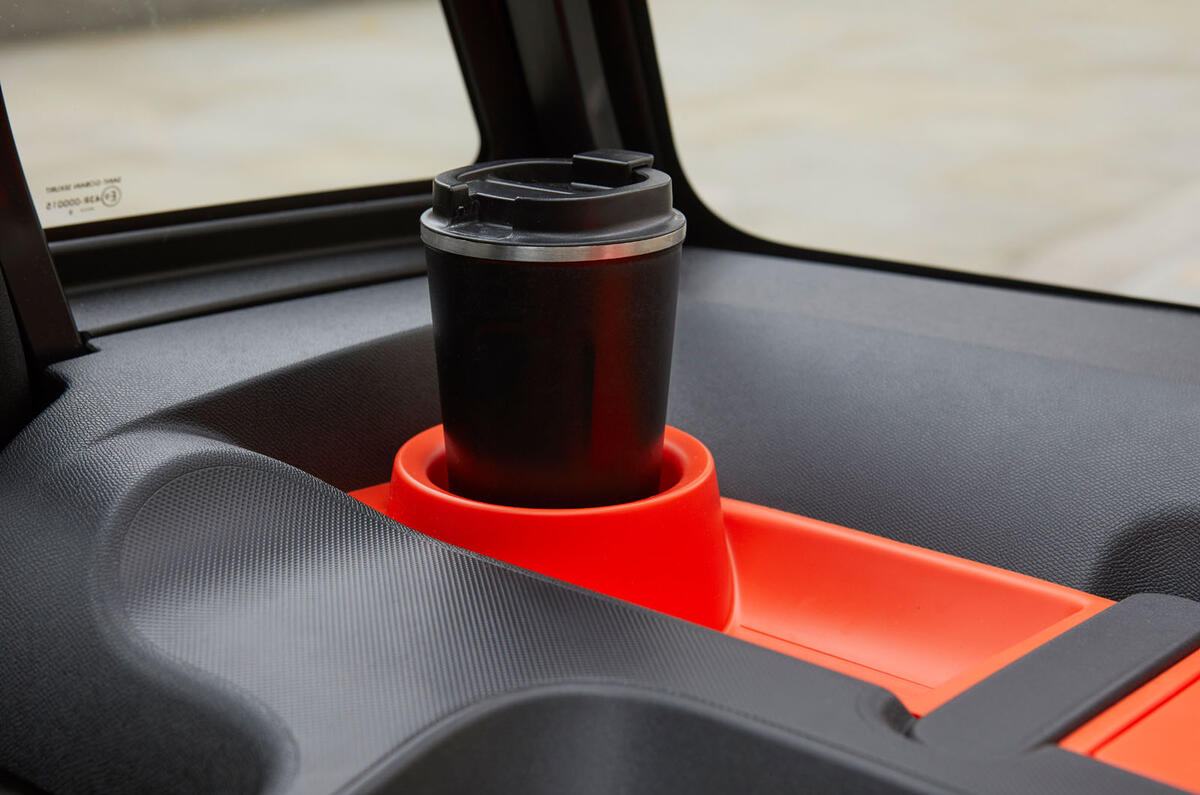
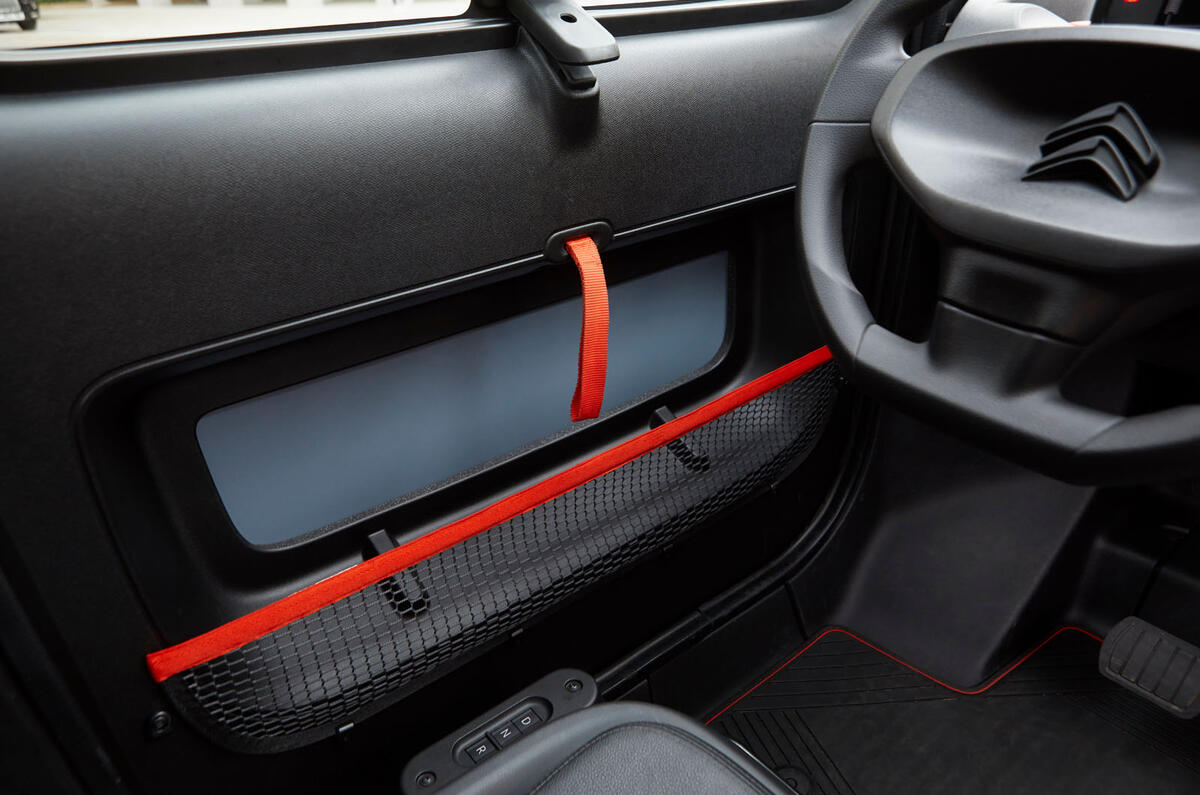
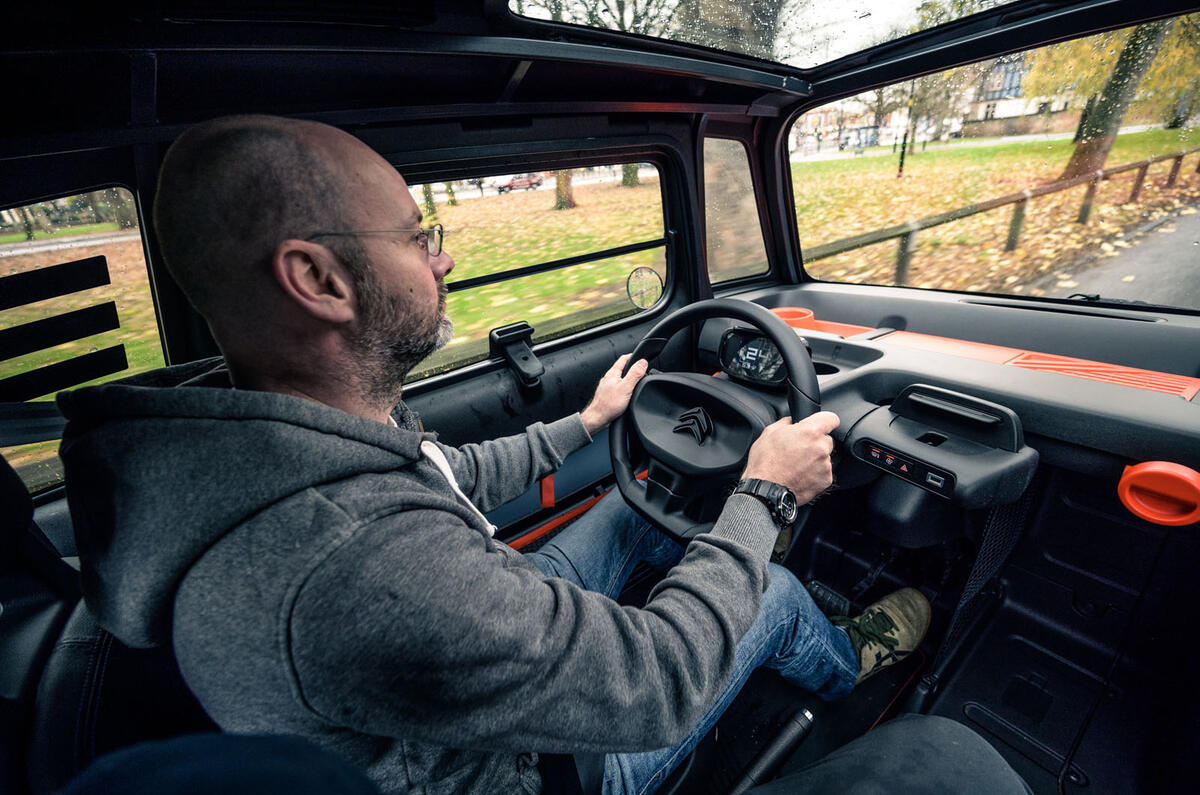
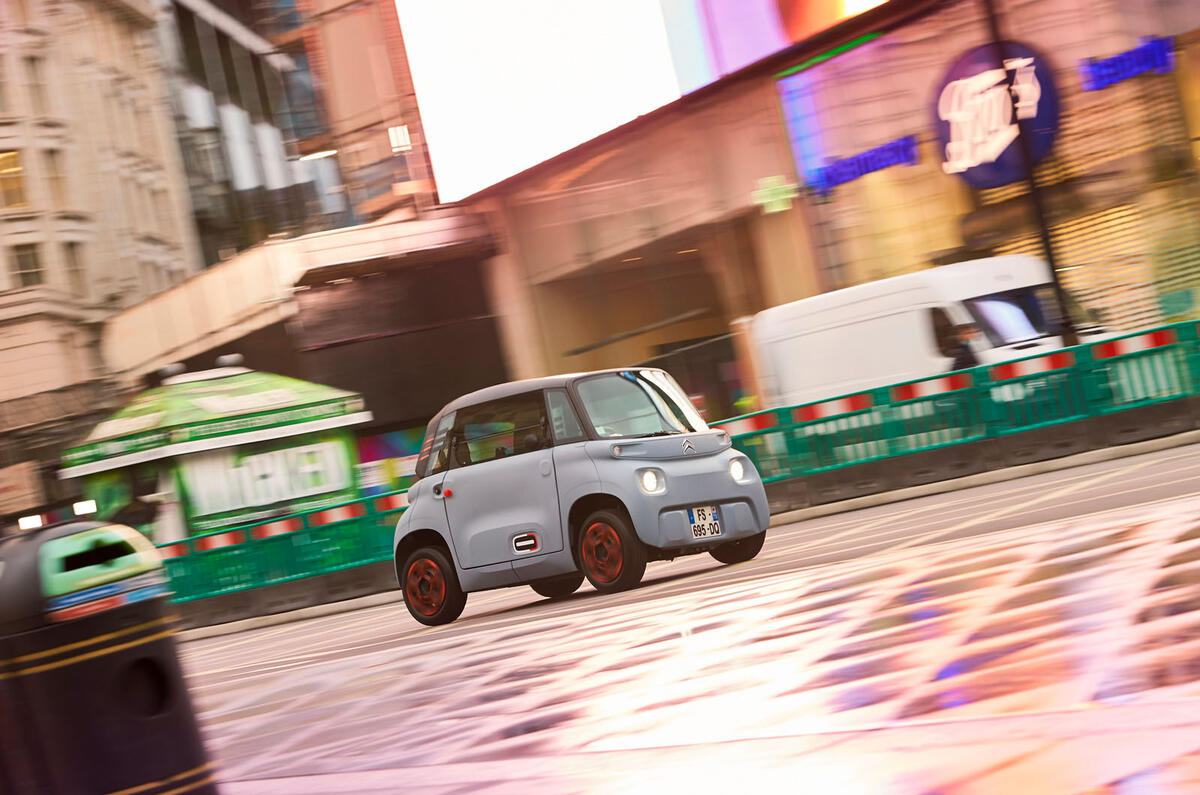
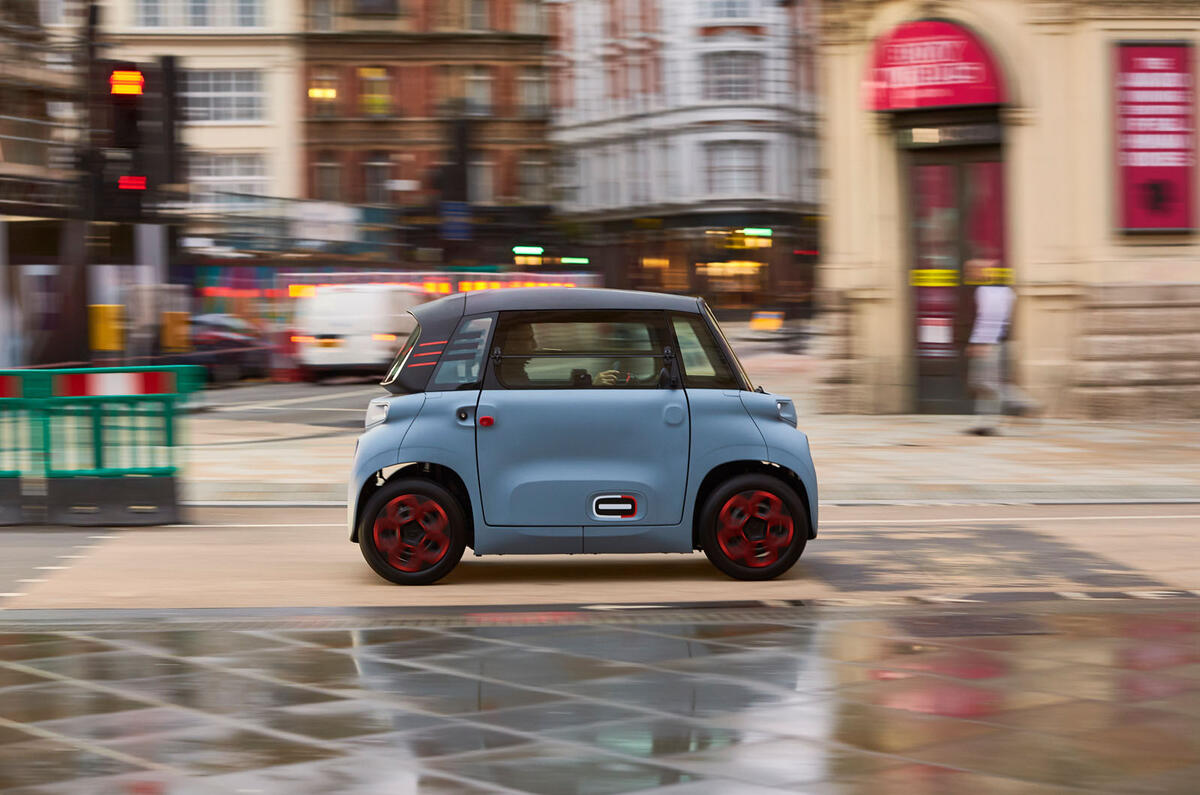
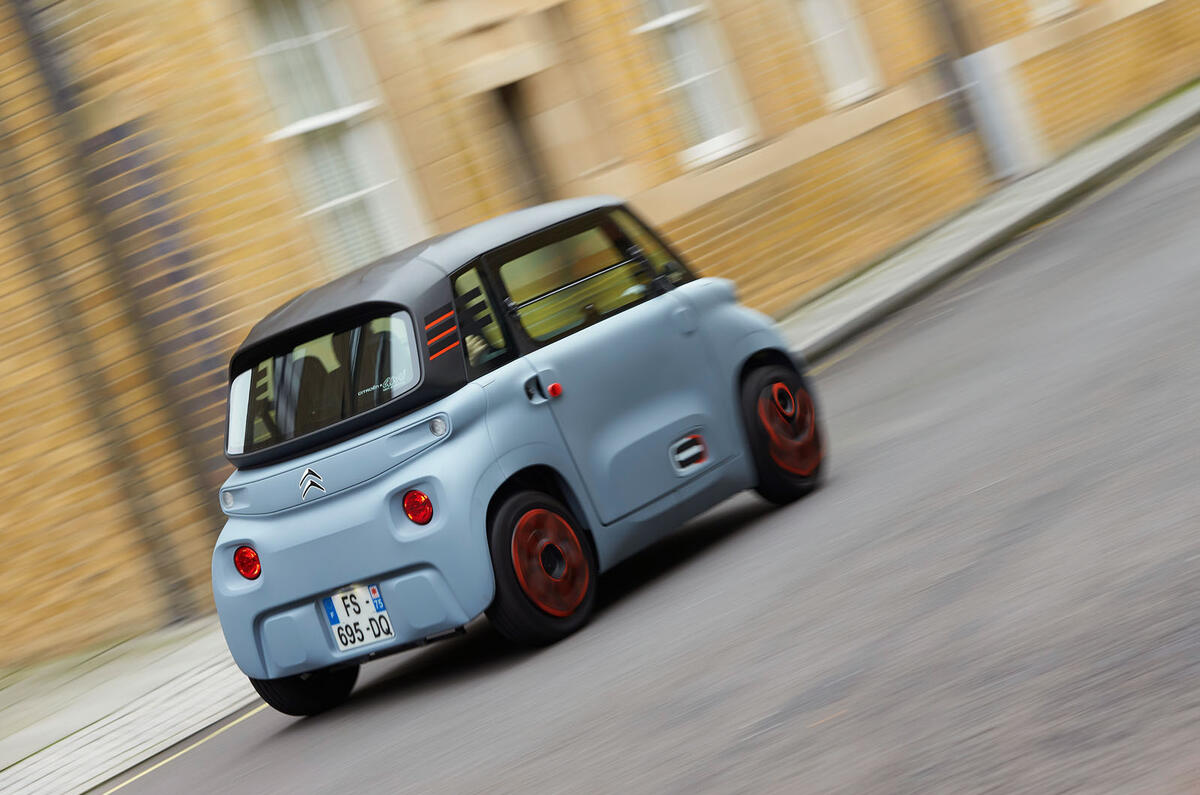
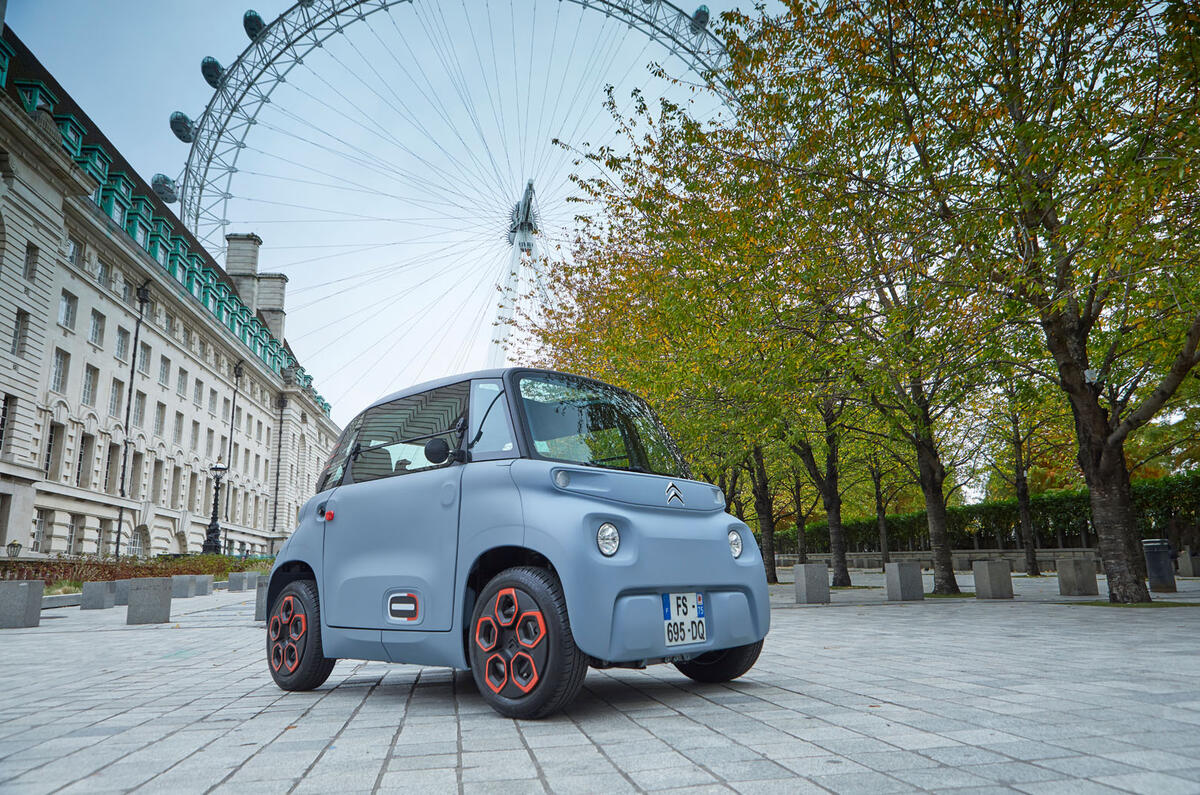
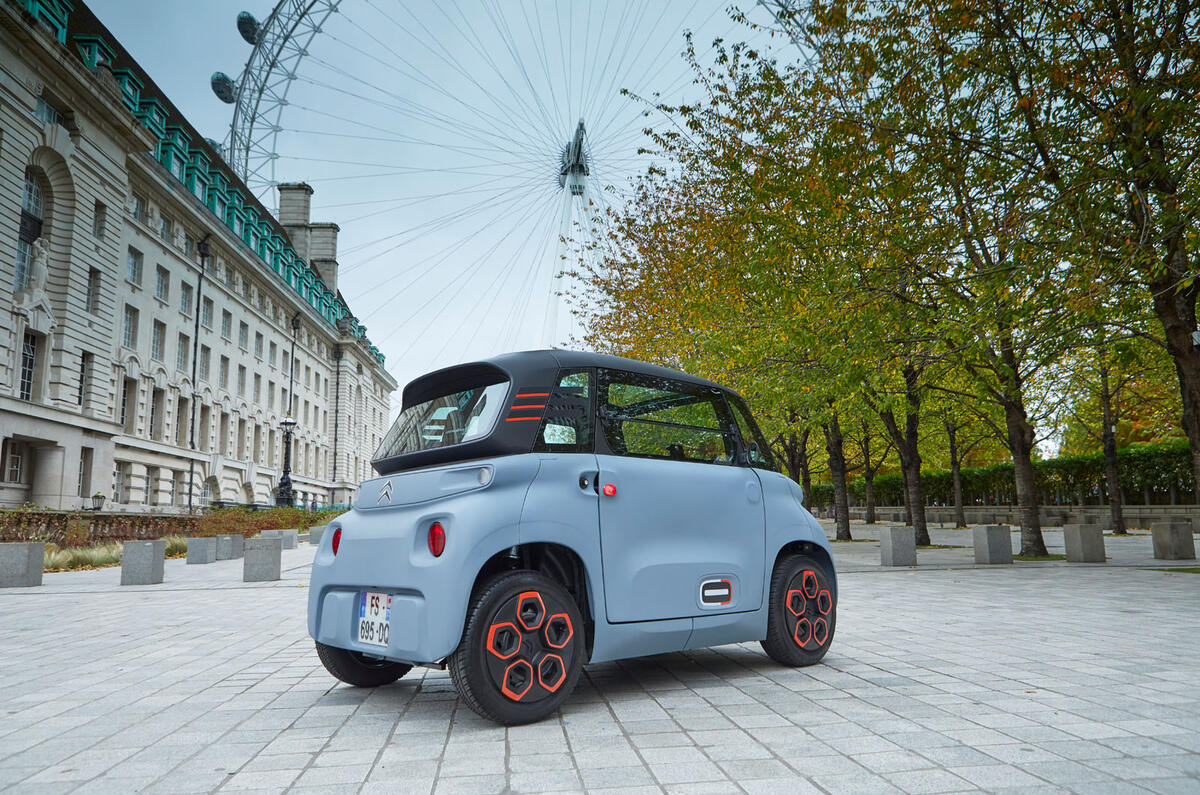
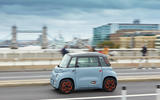
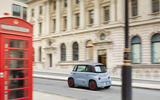
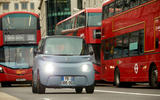
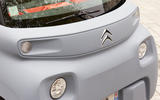
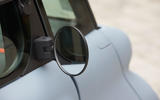
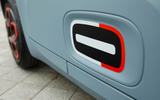
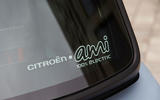
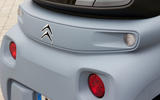
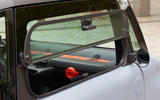
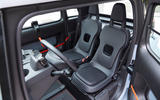
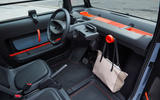
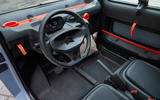
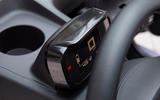
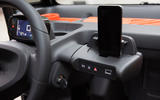
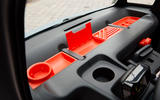
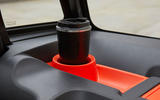
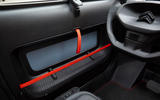

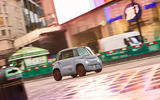
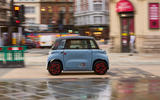
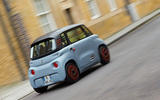
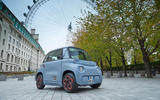
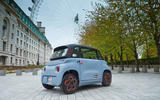





Join the debate
Add your comment
Ugly possible second-car choice, though the minimal range is tight, even for urban dwellers.
Extra seats and a boot. A city car.
So an e up, I agree actually apart from the price rockets up and no one wants to build city cars anymore, which is a shame.
Do that, and it's a Smart car, like you said, it has limited use, if it could be made autonomous it could be used as a way of getting home from a night out for two easier, you could have the extra glass ( that's two these days) and be driven home in one of these!
Matt, I dont think it matters which side the charging socket is located....if the cable has a 3 pin plug where in the urban world are you going to plug it in?!
Only a very select few have a drive in City locations.